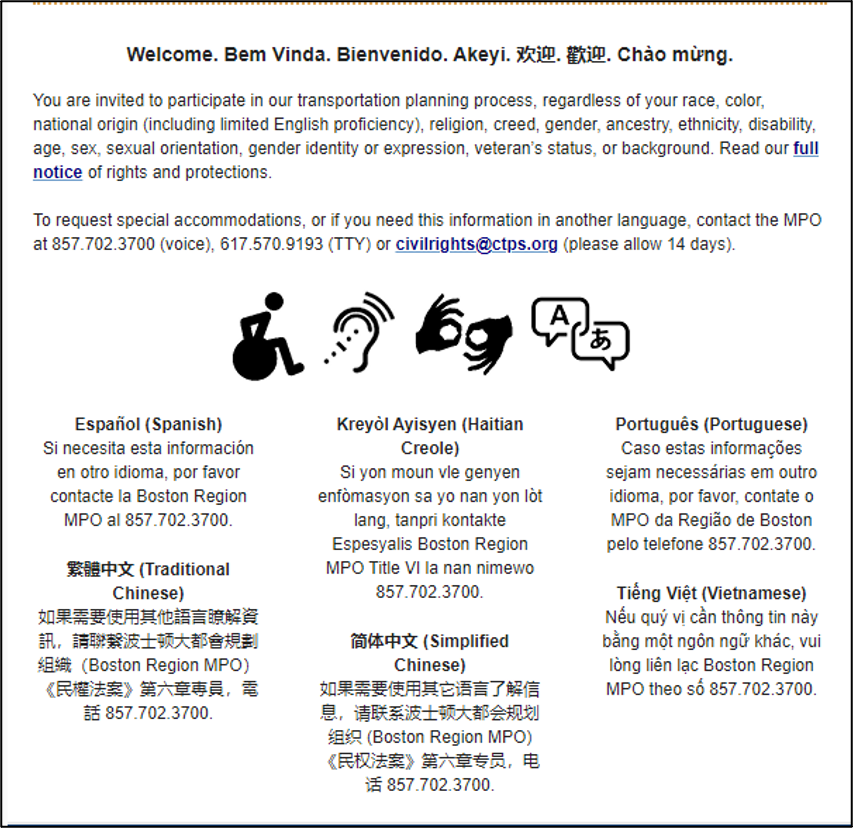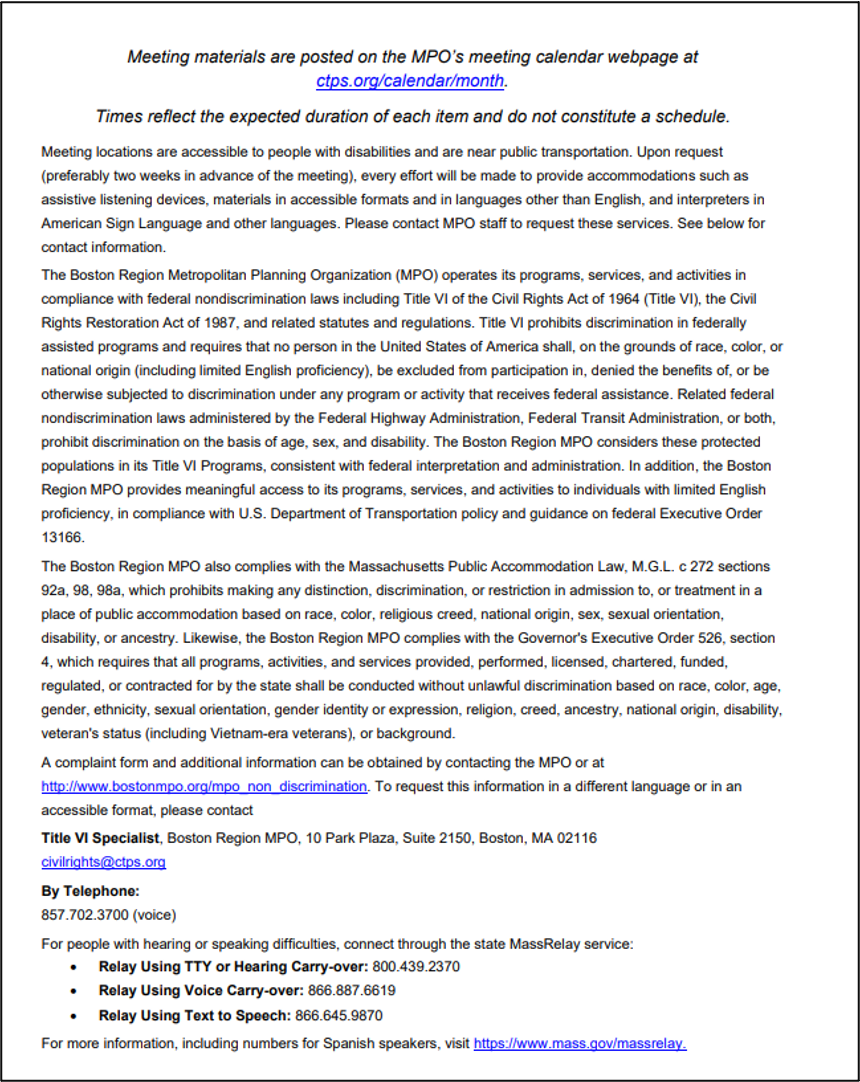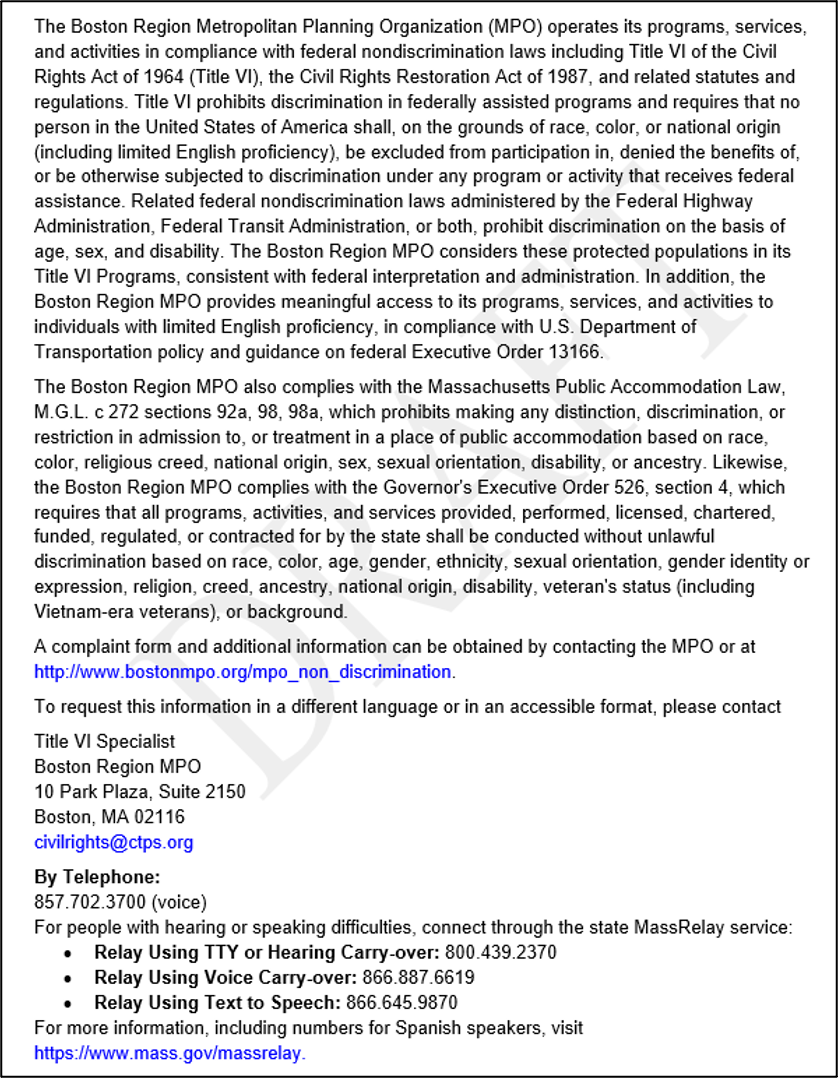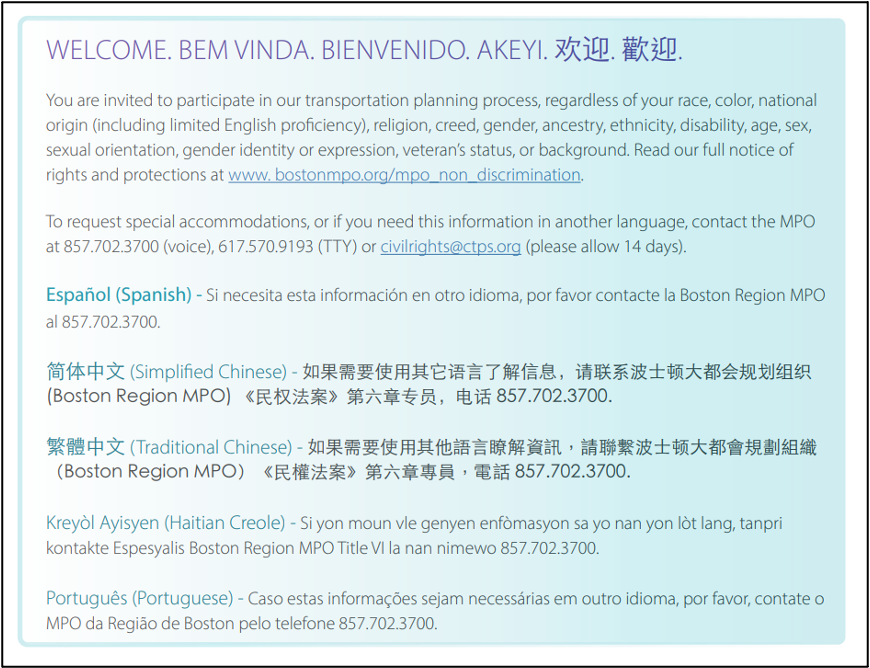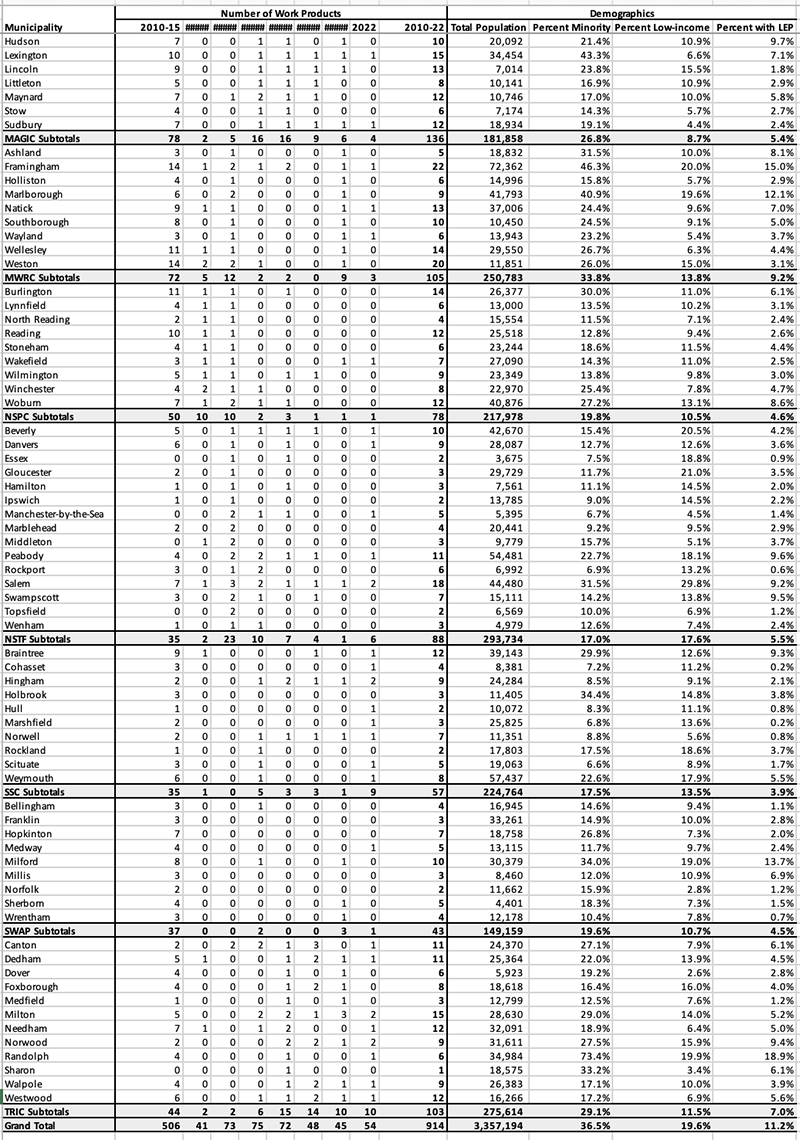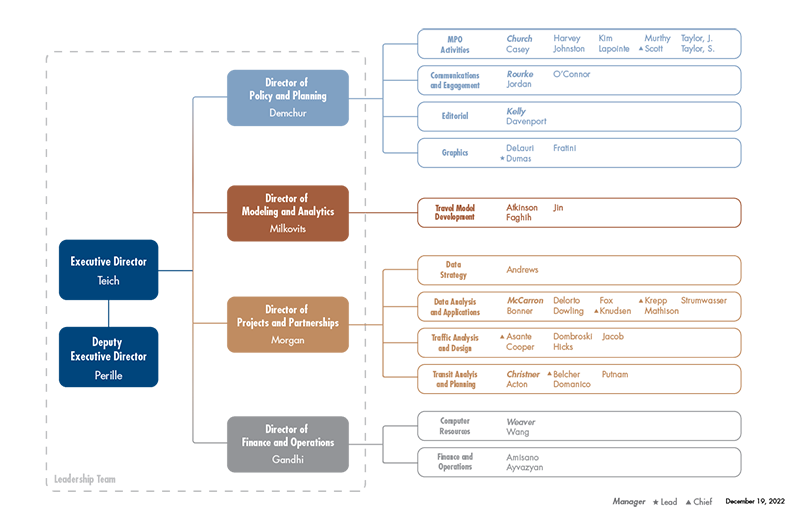
Project Manager
Betsy Harvey
Project Principal
Sarah Philbrick
Graphics and Cover Design
Adriana Fratini
The preparation of this document was supported
by MPO Combined Planning and §5303 Contract #118967
Central Transportation Planning Staff is
directed by the Boston Region Metropolitan
Planning Organization (MPO). The MPO is composed of
state and regional agencies and authorities, and
local governments.
Original submitted December 2022
Revised December 2023
For general inquiries, contact
Central Transportation Planning Staff 857.702.3700
State Transportation Building ctps@ctps.org
Ten Park Plaza, Suite 2150 ctps.org
Boston, Massachusetts 02116
The Boston Region Metropolitan Planning Organization (MPO) operates its programs, services, and activities in compliance with federal nondiscrimination laws including Title VI of the Civil Rights Act of 1964 (Title VI), the Civil Rights Restoration Act of 1987, and related statutes and regulations. Title VI prohibits discrimination in federally assisted programs and requires that no person in the United States of America shall, on the grounds of race, color, or national origin (including limited English proficiency), be excluded from participation in, denied the benefits of, or be otherwise subjected to discrimination under any program or activity that receives federal assistance. Related federal nondiscrimination laws administered by the Federal Highway Administration, Federal Transit Administration, or both, prohibit discrimination on the basis of age, sex, and disability. The Boston Region MPO considers these protected populations in its Title VI Programs, consistent with federal interpretation and administration. In addition, the Boston Region MPO provides meaningful access to its programs, services, and activities to individuals with limited English proficiency, in compliance with U.S. Department of Transportation policy and guidance on federal Executive Order 13166. The Boston Region MPO also complies with the Massachusetts Public Accommodation Law, M.G.L. c 272 sections 92a, 98, 98a, which prohibits making any distinction, discrimination, or restriction in admission to, or treatment in a place of public accommodation based on race, color, religious creed, national origin, sex, sexual orientation, disability, or ancestry. Likewise, the Boston Region MPO complies with the Governor's Executive Order 526, section 4, which requires that all programs, activities, and services provided, performed, licensed, chartered, funded, regulated, or contracted for by the state shall be conducted without unlawful discrimination based on race, color, age, gender, ethnicity, sexual orientation, gender identity or expression, religion, creed, ancestry, national origin, disability, veteran's status (including Vietnam-era veterans), or background. A complaint form and additional information can be obtained by contacting the MPO or at http://www.bostonmpo.org/mpo_non_discrimination. To request this information in a different language or in an accessible format, please contact Title VI Specialist Boston Region MPO 10 Park Plaza, Suite 2150 Boston, MA 02116 civilrights@ctps.org By Telephone: 857.702.3700 (voice) For people with hearing or speaking difficulties, connect through the state MassRelay service:
For more information, including numbers for Spanish speakers, visit https://www.mass.gov/massrelay. |
Please note that the text of some pages in this report may not be accessible to individuals with low or no vision who use a screen reader. These include the Federal Transit Administration and Federal Highway Administration certifications and assurances and the Title VI program MPO member endorsement page. If you would like to request these or any other material in this report in a different format, please contact the Central Transportation Planning Staff via email at civilrights@ctps.org.
The Boston Region Metropolitan Planning Organization (MPO) has prepared this 2022 Title VI Report in response to the Massachusetts Department of Transportation’s (MassDOT) Title VI reporting request. Title VI of the Civil Rights Act of 1964 states that “no persons in the United States shall, on the ground of race, color, or national origin, be excluded from participation in, be denied the benefits of, or be subject to discrimination under any program or activity receiving federal financial assistance.” As a subrecipient of federal funds through MassDOT, the MPO complies with Federal Transit Administration (FTA) and Federal Highway Administration (FHWA) Title VI guidance. FTA and FHWA require that recipients of their financial assistance periodically submit documentation that demonstrates compliance with their Title VI requirements. This report documents that compliance, which is consistent with the principles, federal laws and guidelines, and related requirements of Title VI.
Executive Summary
ES.1.. Background and Purpose
ES.2.. General Reporting Requirements
ES.3.. Reporting Requirements Related to MPO Planning Practices
ES.3.1 Demographic Profiles
ES.3.2 Demographic Maps and Charts of Funding Distribution
ES.3.3 Analysis of MPO System Investments: Identifying and Addressing Disparate Impacts
ES.3.4 Public Engagement: Identifying Mobility Needs
ES.3.5 Data Collection, Reporting, and Analyses
Chapter 1—Purpose and Background
1.1...... Purpose and Content of the Title VI Report
1.2...... The Boston Region MPO Approach to Transportation Equity
1.3...... Federal Requirements and Guidance
1.3.1 Title VI
1.3.2 Environmental Justice
1.3.3 Americans with Disabilities Act (ADA)
Chapter 2—General Reporting Requirements
2.1...... Massachusetts Department of Transportation (MassDOT) Title VI Assurances
2.2...... Federal Transit Administration (FTA) Title VI Certifications and Assurances
2.3...... Title VI Notice of Nondiscrimination
2.4...... Complaint Form and Procedures
2.5...... Title VI Complaint Log
2.6...... Public Engagement Plan
2.7...... Language Assistance Plan
2.8...... Subrecipient Monitoring Process
2.9...... Title VI Program Approval
2.10... Organization and Staffing
2.11... Program Review Procedures
2.12... Title VI Training
2.13... Dissemination of Title VI Information
Chapter 3—Reporting Requirements Related to MPO Planning Practices
3.1...... Demographic Profiles
3.1.1 Demographic Profiles for Title VI and Environmental Justice Populations
3.1.2 Demographic Profiles for Other TE Populations
3.2...... Demographic Maps and Charts of Funding Distribution
3.2.1 Geographical Mapping of TIP Projects
3.2.2 Funding Analysis of TIP Investments
3.2.3 Analysis of TIP Public Transit Investments
3.2.4 Analysis of the Geographical Distribution of UPWP Funds
3.3...... Analysis of MPO Transportation System Investments, Identifying and Addressing Disparate Impacts
3.3.1 Long-Range Transportation Plan Title VI and Environmental Justice Analyses
3.3.2 TIP Title VI and Environmental Justice Analyses
3.4...... Public Engagement: Identifying Mobility Needs
3.4.1 Building a Foundation: Developing and Strengthening Community Relationships
3.4.2 Collecting and Identifying Needs
3.4.3 Facilitating Engagement through the MPO Planning Process
3.5...... Data Collection, Reporting, and Analyses
3.5.1 Quantitative Data
3.5.2 Qualitative Data
Table 1 Minority Population in the Boston Region.
Table 2 2021 MPO Low-income Thresholds
Table 3 Low-income Population in the Boston Region
Table 4 People with LEP in the Boston Region
Table 5 Safe Harbor Languages in the Boston Region
Table 6 People with Disabilities, Older Adults, and Youth in the Boston Region
Table 7 MBTA Ridership by Minority Status
Table 8 MBTA Ridership by Income
Figure 1 CTPS Organizational Chart
Figure 2 Percent of the Minority Population in the Boston Region
Figure 3 Percent of the Low-income Population in the Boston Region
Figure 4 Percent of the Population with LEP in the Boston Region
Figure 5 Percent of the Population with a Disability in the Boston Region
Figure 6 Percent of the Older Adult Population in the Boston Region
Figure 7 Percent of the Youth Population in the Boston Region
Figure 8a Boston Region MPO TIP Transit Projects (FFYs 2023–27 TIP)
Figure 8b Boston Region MPO TIP Transit Projects (FFYs 2023–27 TIP): Detailed Map
Figure 9 Change in the Percent of Funding Allocated to TE Populations in the TIP
Figure 10a Public Transit Investments in the TIP: All Investments
Figure 10b Public Transit Investments in the TIP: Target-funded Investments
Figure A-1 Full Notice of Nondiscrimination
Figure A-2 MPO Email Notice of Nondiscrimination
Figure A-3 MPO Agenda Notice of Nondiscrimination
Figure A-4 Memo and Report Notice of Nondiscrimination
Figure A-5 Office Notice of Nondiscrimination
Figure A-6 Public Meeting Notice of Nondiscrimination
Figure A-7 Notice of Nondiscrimination for Public Engagement Materials
Appendix A Notice of Nondiscrimination Samples
Appendix B Complaint Forms
Appendix C Complaint Procedures
Appendix D Language Assistance Plan
Appendix E Long-Range Transportation Plan Title VI and EJ Analyses: Destination 2040
Appendix F Transportation Improvement Program Title VI and EJ Analyses
Appendix G Analysis of the Geographic Distribution of UPWP Funds
Appendix H Public Engagement Plan
Executive Summary
This document responds to the Massachusetts Department of Transportation’s (MassDOT) 2022 Title VI reporting requirements for the Boston Region Metropolitan Planning Organization (MPO). As a subrecipient of federal funding from both the Federal Transit Administration (FTA) and Federal Highway Administration (FHWA) through MassDOT, the MPO is required to comply with these agencies’ civil rights guidance for MPOs—FTA’s triennial reporting requirements under Title VI of the Civil Rights Act of 1964 and FHWA’s annual reporting requirements under its Title VI/non-discrimination program.
The authorities that underpin FTA and FHWA guidance include the following:
Both the FTA and FHWA require the MPO to comply with these civil rights mandates by implementing a Civil Rights Program and to monitor and report regularly on the program’s efforts. The MPO’s compliance efforts are fulfilled under its Transportation Equity (TE) program, which includes civil rights compliance activities. The broader TE program works to engage with and improve transportation outcomes for traditionally underserved and overburdened populations, collectively referred to as TE populations: minority populations, low-income populations, people with limited English proficiency, people with disabilities, older adults, and youth.
The report reflects the MPO’s Title VI compliance efforts since July 2021, as requested by MassDOT. These efforts are critical not only because they comply with federal regulations, but also because they are sound transportation-planning practices that further the MPO’s vision of providing equitable transportation access and meaningful involvement in its decision-making process to all residents in the region regardless of their background.
The following general reporting requirements are included in this report:
Demographic profiles are a collection of maps and tables that show the locations and concentrations of protected populations in the Boston region. The MPO includes demographic profiles for minority populations, people with limited English proficiency, and people with disabilities—as well as other covered populations included among the MPO’s TE populations, people with disabilities, older adults (ages 75 and older), and youth (17 and younger).
This map shows the geographical distribution of projects in the federal fiscal years (FFYs) 2023–27 Transportation Improvement Program (TIP)—both target and non-target funded projects—overlaid on the distribution of minority and low-income populations in the Boston region.
This analysis compares the distribution of the MPO’s discretionary (or “regional target”) funding allocated to TE populations to their respective share of the regional population. It covers the last five TIP cycles, the FFYs 2019–23 through FFYs 2023–27 TIPs. Results show that the percent of funding allocated to the minority population has consistently been less than the percent of their population in the Boston region. The other TE populations have been allocated approximately the same percent of funding compared to their respective share of the population in the region.
This analysis examines the distribution of state and federal funds, in the aggregate, to minority and low-income passengers for public transit projects, and compares it to that for non-minority and non-low-income passengers, respectively. It covers the last five TIP cycles, the FFYs 2019–23 through FFYs 2023–27 TIPs.
Over the past five years, funding for transit investments from all sources, including MPO target funds, peaked in the FFYs 2019–23 TIP for all populations and then decreased. Among target funds, the amount of funding allocated to minority and low-income populations on a per-person basis has consistently been less than for the non-minority and non-low-income populations, respectively; however, that difference has decreased over the past few years. This has also been the case for all public transit investments made in the Boston region.
Each year in the UPWP, the MPO produces a geographical assessment of the distribution of MPO-funded studies. It cites which communities in the region have been the subject of these studies, as well as the share of the low-income and minority populations in these communities. The results can be found in Appendix G. Overall, there does not appear to be a clear pattern between the number of studies and the percent of a municipality’s residents who are minority or low-income, or who have limited English proficiency. Boston, for example, has been the subject of 60 studies since 2010 and has among the highest percentages of these populations. In contrast, Randolph, where 73.4 percent of the population is minority, had only six studies.
The MPO analyzes the projects, in the aggregate, that are proposed in its LRTP to identify potential impacts—called disparate impacts—for minority populations and disproportionate burdens for low-income populations. In 2020, the MPO adopted its Disparate Impact and Disproportionate Burden (DI/DB) Policy that, sets thresholds for determining whether a collection of projects would cause disparate impacts and/or disproportionate burdens. The MPO’s most recent LRTP, Destination 2040, evaluated these impacts, using several metrics related to accessibility, mobility, and air quality. The analysis found that the LRTP would not cause disparate impacts or disproportionate burdens.
The TIP Title VI and EJ analyses assess which TE populations are likely to be served or impacted by regional target-funded projects programmed in the TIP. There are several analyses that provide this insight:
Meaningful and equitable public engagement is foundational to the MPO’s planning and decision-making. The MPO’s approach to engagement is centered on the development of strong relationships with members of the community, particularly groups and organizations representing Title VI and EJ populations who have historically been underrepresented in the planning process.
There are several ways through which the MPO identifies transportation needs. One is through the ongoing Needs Assessment for the LRTP, which supports the development of investment programs and projects in the LRTP. Needs voiced by the public during a wide range of engagement activities are cataloged in the Needs Assessment, and all feedback and comments are organized into theme areas. They are further grouped by equity tags (such as transportation concerns that are related to minority populations or people with limited English proficiency).
Another avenue is the MPO’s Coordinated Public Transit-Human Services Transportation Plan (Coordinated Plan). One of the main functions of the plan is to identify unmet transportation needs for seniors and people with disabilities in the Boston region through extensive public engagement and identify strategies and actions to meet those needs. Public engagement for the Coordinated Plan is done in conjunction with the Needs Assessment to ensure the input from seniors and people with disabilities informs LRTP decisions.
Several other examples illustrate specifically how public engagement is facilitated through the MPO planning process. One is the comprehensive public engagement process undertaken between 2018 and 2022 to develop the LRTP DI/DB Policy. At the core was a stakeholder working group convened with the primary purpose of guiding the MPO's decision on setting the values of the three thresholds included in the DI/DB Policy. Another was in 2021 when staff conducted extensive surveying and public engagement, with a focus on getting input from disadvantaged populations and communities, to update the criteria for the TIP project selection process. A final example is in MPO-funded studies and technical assistance. Staff strive to include the collection of qualitative data through meaningful community participation in all studies, particularly those that have an equity focus or involve communities where there is a high share of EJ or Title VI populations.
The MPO staff collects demographic data on Title VI, EJ, and other nondiscrimination populations primarily from the Decennial Census (DC) and American Community Survey (ACS). Staff collect new data each year when new datasets are released. They are used in equity-related analyses in the TE Program, including the Language Assistance Plan, and Title VI and EJ analyses for the LRTP and TIP, among other analyses for the TE Program.
The MPO has shifted toward analyses that focus on understanding project impacts on TE populations, rather than assuming that people who live near a project will benefit from it. To do so, staff also collect a variety of transportation related data, such as crash data, climate change data, and air quality data through other MPO programs, and these data are shared with the TE Program. The MPO’s new Data Program will also facilitate a more comprehensive approach to managing data across the agency. From the perspective of the Title VI Program, this will help ensure consistency in how the data are collected and used by the MPO staff, as well as allow the program to capitalize on emerging datasets, demographic and otherwise, and analysis tools.
This document describes the Boston Region Metropolitan Planning Organization’s (MPO) work related to its Title VI Program as requested by the Massachusetts Department of Transportation (MassDOT). A subrecipient of MassDOT, the MPO receives federal dollars from the Federal Highway Administration (FHWA) and the Federal Transit Administration (FTA) and must comply with these agencies’ Title VI reporting requirements. In their roles in carrying out the mission and directives of Title VI, the FHWA and FTA each issue guidance for recipients of their financial assistance regarding compliance with Title VI.
This report conforms with the requirements set out in FHWA’s Environmental Justice Reference Guide and FTA’s Title VI Circular 4702.1B and environmental justice (EJ) Circular C 4703.1. To demonstrate compliance with FHWA’s Title VI and non-discrimination requirements, this document also reports on parallel efforts to engage and accommodate a broader set of protected populations through the MPO’s Transportation Equity (TE) Program.
This chapter provides background on the MPO and the federal mandates that underpin the MPO’s Title VI Program. Chapter 2 demonstrates how the Boston Region MPO has satisfied general reporting requirements. Chapter 3 demonstrates how the MPO has satisfied requirements related to MPO planning practices.
Covering 97 municipalities in eastern Massachusetts, the MPO consists of a 22-member board of state agencies, regional transportation-planning organizations, and elected local officials. MPO members, supported by the MPO staff, are responsible for allocating federal funds for public transit, roadway, bicycle, and pedestrian projects in the Boston region. They are also responsible for setting the region’s transportation vision, goals, and objectives. These are reflected in the MPO’s studies, public engagement process, project selection, and the federally required documents that MPO staff produces.
One of the MPO’s goal areas is Transportation Equity. This goal, along with its accompanying objectives, is the foundation of the MPO’s approach to its TE Program. The TE Program, while encompassing the MPO’s Title VI Program, goes beyond these requirements to fully incorporate TE in all MPO planning activities and decision-making. The MPO’s TE goal is to
Ensure that all people receive comparable benefits from, and are not disproportionately burdened by, MPO investments, regardless of race, color, national origin, age, income, ability, or sex
Several objectives provide measurable specifics that help staff develop concrete work activities to advance the MPOs goals:
Through the MPO’s TE Program, the MPO ensures compliance with federal nondiscrimination laws and several Executive Orders (EOs). The following subsections discuss the federal statutes and EOs that govern the MPO’s civil rights activities, the regulations and guidance that direct their implementation, and the populations covered by each.
Title VI of the Civil Rights Act of 1964 states that “no person in the United States shall, on the grounds of race, color, or national origin, be excluded from participation in, be denied the benefits of, or be subjected to discrimination under any program or activity receiving federal financial assistance.” As a recipient of federal financial assistance from FHWA and the FTA, the MPO documents its efforts to ensure that its activities, programs, and services are not discriminatory on these grounds.
Discrimination on the basis of limited English language proficiency (LEP) also qualifies as discrimination on the basis of national origin. EO 13166, Improving Access to Services for Persons with Limited English Proficiency, and several subsequent iterations of clarifying guidance led to LEP being recognized as the primary way of identifying national origin. EO 13166 directs federal agencies to take reasonable steps to provide meaningful language access in their services, and for all recipients of any federal financial assistance to do the same.
Environmental justice at the federal level is based on EO 12898, Federal Actions to Address Environmental Justice in Minority Populations and Low-income Populations. This EO instructs federal agencies to identify and address any disproportionately high and adverse human health and environmental effects of their programs, policies, and activities on minority and low-income populations. To this end, each agency must develop strategies to incorporate EJ principles into their operations and into those of the recipients of their financial assistance; these requirements are passed through to their recipients of federal financial assistance.
The ADA prohibits public entities from discriminating against people with disabilities or excluding them from participating in, or denying them the benefits of, the entities’ services, programs, or activities. Although disability protections are not explicitly a part of Title VI, they are implied in the inclusive public participation requirements and are part of FHWA’s EJ reference guide. For MPOs, this means that public meetings are held in accessible buildings and that MPO documents are available in accessible formats to members of the public.
Signed assurances are located at the front of this document.
Signed certifications and assurances are at the front of this document.
The Boston Region MPO’s notice of nondiscrimination, updated in 2022 and adapted from a MassDOT prototype, can be found in Appendix A. The notice is translated into the MPO’s six Safe Harbor languages, available in full on the MPO’s website. Modified versions are included in all documents and public engagement materials and include links to the full version online. Should analysis show the need to include additional languages, the notice will be updated accordingly.
The MPO’s Title VI complaint forms and procedures were updated in 2022 and adapted from MassDOT prototypes. They may be found in Appendices B and C.
The MPO has not received any Title VI complaints or been involved in any Title VI investigations or lawsuits since July 2021.
The MPO’s Public Engagement Plan (PEP) may be found in Appendix H. No major overhauls of the current PEP, which was endorsed on September 15, 2022, are currently planned. MPO staff continue to make minor changes as needed to ensure that the PEP reflects and supports the public engagement processes for the MPO’s certification documents and state and federal guidance. Staff await the release of MassDOT’s updated Public Participation Plan and will update the PEP as necessary to reflect any changes.
Minor changes to the PEP currently planned include updating Appendix B of the PEP with a revised set of demographic questions included in MPO surveys based on demographic data collection best practices. The Regional Transportation Advisory Council section of the PEP also will be updated to reflect the Communications and Engagement Program’s administration of the MPO’s Advisory Council and plans for closer coordination and collaboration on engagement work.
The MPO’s Language Assistance Plan (LAP) was updated in 2021. A copy of the LAP may be found in Appendix D.
MPO staff monitor recipients of federal funding distributed through the MPO to ensure they comply with federal civil rights regulations. The MPO’s Title VI Coordinator is responsible for implementing, monitoring, and ensuring compliance, with direction from the Manager of the MPO Policy and Planning group and the Director of Policy and Planning. The Title VI Coordinator is responsible for the following activities:
As monitoring subrecipients is a new process for the MPO, the Title VI Coordinator will continue to consult with ODCR on updating these monitoring procedures as needed.
This report was endorsed by the Boston Region MPO on March 2, 2023. The minutes documenting this approval are in Appendix I.
The diagram in Figure 1 shows the organizational chart for the Central Transportation Planning Staff (CTPS), which is the staff to the Boston Region MPO, and the Title VI Coordinator position in relation to the Executive Director position.

The MPO’s Title VI Program is part of the broader Transportation Equity (TE) Program. The TE Program carries out the civil rights, environmental justice (EJ), nondiscrimination, and other equity-related activities for the Boston Region MPO. The program seeks to ensure that people who historically have been excluded from participating in the MPO transportation-planning process, and who have been unfairly burdened by the transportation system, have a voice in the selection of transportation investments in their communities, and are no longer overburdened or underserved by the transportation system. Through the TE Program, the Boston Region MPO remains committed to a transparent and accessible transportation-planning process as it considers all residents’ needs when developing its plans and selecting the studies and projects it funds, toward the goal of improving transportation outcomes for TE populations.
More specifically, the TE Program houses the MPO’s Title VI Program, which ensures compliance with all federal nondiscrimination . There are several ways in which the MPO’s Title VI Coordinator confirms Title VI requirements are being met by the MPO:
Each year, staff carry out the following activities to maintain compliance with Title VI, EJ, and other nondiscrimination requirements.
CTPS staff have not attended Title VI-specific trainings hosted by state or federal partners since July 2021. However, staff have attended these trainings in the past and will continue to do so as opportunities arise. Additionally, the MPO is a member of the Association of Metropolitan Planning Organizations (AMPO) and have attended meetings of AMPO working groups as Title VI and EJ topics arise, including the Public Participation Working Group and the Data and GIS Working Group. Staff also attend Transportation Management Group (TMG) meetings and TMG’s Data Working Group, where Title VI and EJ content are often discussed. Staff also regularly present at the state and national level on equity- and Title VI-related topics; in the past year, these events have included the following:
Additionally, staff are in the process of developing internal training guides for CTPS staff on providing language access. This will help the MPO maintain consistency throughout its various translation and interpretation practices and provide clarity among staff for their responsibilities. Guides on additional Title VI and other nondiscrimination topics will likely be developed as well.
The MPO’s communications strategy is multifold, using several forms of communication with the goal of reaching as many members of the public as possible. These include messaging on the MPO’s MailChimp email account, social media (Twitter, Facebook, LinkedIn, YouTube, and Instagram), the MPO’s website, and at the various board and committee meetings, stakeholder meetings, and public events that are hosted both virtually and in person. In the past, physical notifications of events, such as flyers, have been used, but the COVID-19 pandemic accelerated the MPO’s use of digital media as the main way through which information is communicated to the public, including the dissemination of Title VI information.
The MPO’s website is the main way the agency distributes information about MPO activities, documents, and opportunities for public input, and where notices of public engagement events are posted. It is also the main hub for the MPO’s Title VI information. It contains the full notice of nondiscrimination, complaint forms, and complaint procedures, which are all translated into the MPO’s Safe Harbor languages. To ensure accessibility, all documents are posted on the website in both PDF and HTML formats to accommodate people with low or no vision. In addition, documents may be obtained upon request in a variety of formats, including Braille and large print. Members of the public may also request meeting materials in accessible formats by email, telephone, or US mail.
Additionally, the MPO website has an embedded Google Translate widget that allows visitors to the site to translate web text into more than 100 languages. In FFY 2023, CTPS acquired a new web translator tool, Localize, which allows a customized experience and higher quality translations for the website. The transition to Localize is currently underway. It will limit the number of languages the website can be translated into to the MPO’s six Safe Harbor languages—Spanish, Chinese (simplified and traditional), Portuguese, Haitian Creole, and Vietnamese, which cover 75 percent of non-English speakers. However, the quality of the translations will be far greater than is currently available. Once Localize is implemented, staff will track the usage of Localize and other language data.
All public facing documents (such as memos and reports) contain the full or abbreviated notice of nondiscrimination, notification that translations are available upon request, and that accessible accommodations can be made available upon request. MPO board and committee meetings, when they are in-person, contain a mounted foam-core board with the notice of nondiscrimination. In virtual MPO board and committee meetings, the slide deck contains the notice of nondiscrimination and information about how to obtain information in other languages and accessible formats. This information is read out loud by the meeting chair.
The MPO uses several email lists to notify interested parties about upcoming MPO meetings and associated agendas, public review periods, amendments to documents, and other ways in which they may be involved in the MPO planning process. Every email contains Title VI information, including an abbreviated notice of nondiscrimination and a link to the full notice on the website, information about how to translate emails (which is done via machine translation through Google Translate), and a notice that additional translations can be provided upon request.
All public engagement materials, including surveys, plain language booklets, meeting agendas, and presentations, contain the notice of nondiscrimination and information about how to request translations and accessible accommodations. Registration forms for MPO events also include a field that asks if translations or accessible accommodations will be needed.
In accordance with the MPO’s LAP (see Appendix D), vital documents are translated into the six most spoken non-English languages in the Boston region—Spanish, Chinese (simplified and traditional), Portuguese, Vietnamese, and Haitian Creole. Vital documents include the notice of nondiscrimination rights and protections to beneficiaries, complaint forms and procedures, public engagement documents such as surveys and meeting materials, executive summaries of the MPO’s core planning documents (the LRTP, TIP, UPWP, Coordinated Public Transit-Human Services Transportation Plan, Public Engagement Plan, and the Title VI Triennial Report). Anyone may request a translation of any document in any language. The LAP is translated in its entirety. All translated documents also include translated versions of the notice of nondiscrimination and the ability to request translated and accessible versions of documents.
Metropolitan planning organizations are required to develop demographic profiles for the purpose of identifying minority populations under the FTA’s Title VI Circular 4703.1B. In addition to Title VI and EJ populations, the MPO also includes other TE populations—older adults, people with disabilities, and youth—in the MPO’s TE Program. These three populations were chosen because of nondiscrimination protections afforded to them, as well as because they often encounter transportation disadvantage and may face barriers to participating in the transportation planning process. The data gathered during these efforts, as well as the profiles themselves, contribute to the MPO’s planning and analysis efforts while developing 3C documents and programs, conducting UPWP studies, and undertaking public engagement.
MPO staff updates demographic profiles as new Census data become available. For this report, data from the 2020 Decennial Census and the 2016–20 American Community Survey (ACS) were used.1
The MPO uses the FTA’s and FHWA’s definition of minority persons: people who are American Indian/Alaska Native; Asian; Black/African American; Hispanic/ Latino, regardless of race; and/or Native Hawaiian or other Pacific Islander. Minority populations are defined as readily identifiable groups of minority persons who live in geographic proximity, or, if warranted, geographically dispersed or transient populations.
Table 1 shows the number and percent of the minority population in the Boston region, while Figure 2 shows the percent of the minority population in block groups in the Boston region. In all, 1,223,835 people identify as a minority in the Boston region, or 36.5 percent of the total population. This is an increase of 40.6 percent compared to 2010.
Source: 2020 and 2010 Decennial Censuses Redistricting Files, Table P2.
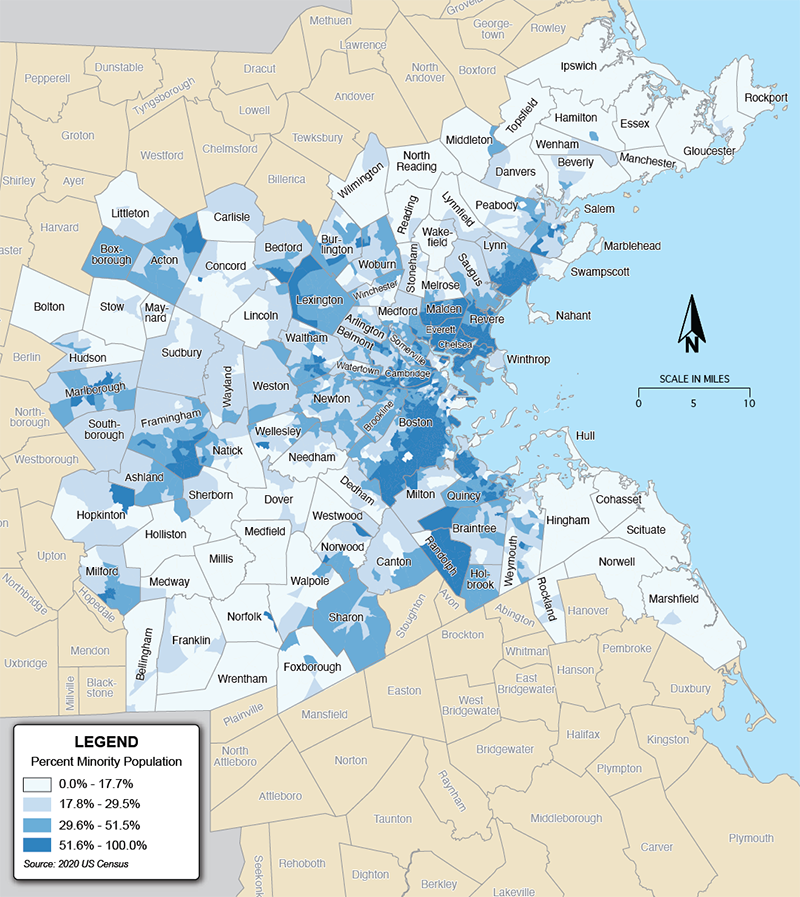
Source: 2020 Decennial Census Redistricting File, Table P2.
The MPO defines the low-income population as people whose family income is less than or equal to 200 percent of the federal poverty level (FPL) for their family size. Because the FPLs are recalculated each year, the MPO’s low-income thresholds vary slightly in accordance with these changes. Table 2 shows the low-income thresholds that the MPO uses based on the 2021 FPL.
Note: The MPO’s low-income thresholds use the weighted averages across all family sizes as determined by the US Census Bureau. Where the MPO use data directly from Census Table C17002 (such as in demographic profiles; see Table 3 and Figure 2), thresholds correspond with those based on family size (rather than weighted averages).
Source: US Census Bureau.
Table 3 shows the number and percent of the low-income population in the Boston region, while Figure 2 shows the percent of the low-income population in block groups in the Boston region. In all, about 715,740 people have low incomes in the Boston region, or 20.1 percent of the total population. This is a decrease of 5.8 percent compared to 2010.
Source: 2016–20 and 2010–14 American Community Surveys, Table C17002; 2020 and 2010 Decennial Census Redistricting File, Table P2.
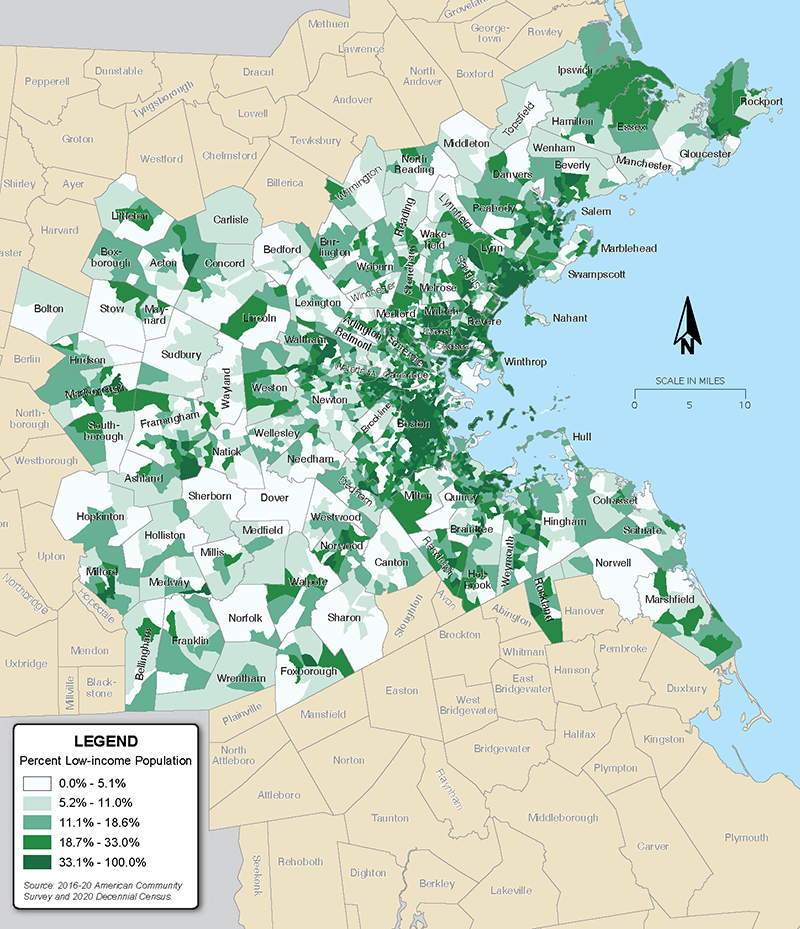
Source: 2016–20 America Community Survey, Table C17002.
People with LEP are defined by federal regulations as persons for whom English is not their primary language and who have a limited ability to read, write, or understand English. For the purposes of Title VI reporting, FTA defines LEP persons as those aged five and older who report to the US Census Bureau that they speak English less than “very well.” This definition is used by the MPO.
Data from the 2016–20 ACS show that 11.2 percent of the Boston region population five years and older have LEP. Table 4 shows the count of the LEP population and total population, the percentage of the general population that are LEP, and the percentage change in LEP population from 2010 to 2020. About 375,848 people have LEP, which is 8.7 percent of the total population. This is a 14.7 percent increase compared to 2010.
Source: 2020 and 2010 Decennial Censuses Redistricting Files, Table P2; 2016–20 and 2010–14 American Community Surveys, Table B16004.
Figure 4 shows the distribution of people with LEP within the Boston region. Maps that show the distribution of where Safe Harbor languages are spoken may be found in Appendix D, the Boston Region MPO’s 2021 LAP.
Source: 2016–20 American Community Survey, Table B16004.
The Boston MPO last updated the LAP in 2021 and therefore did not conduct a new update for this report. The data shown in Table 4 and Figure 3 are from the 2016–20 five-year ACS, while the data in the LAP included in the Appendix are from 2015–19 five-year ACS and Public Use Microdata Sample (PUMS) as these were the data available at the time.
In the LAP, the MPO identified the region’s Safe Harbor languages—non-English languages that are spoken “well,” “not well,” or “not at all” by at least 1,000 people or at least 5 percent of the population (whichever is less). These languages are listed in Table 5. Note that the number of LEP persons who speak Safe Harbor languages (345,218) is less than the total number of LEP persons in the region (349,345). This is because Safe Harbor languages do not include every non-English language that is spoken, only those that meet one or both thresholds. Spanish is the most spoken non-English language in the region, with approximately 126,018 speakers, which is 36.5 percent of all LEP persons and 4.0 percent of the entire population aged five and older. It is followed by Chinese, Portuguese, French Creole, and Vietnamese.
Vital documents are not translated into all of these languages. Vital documents are translated into the six most commonly spoken non-English languages—Spanish, Chinese (including traditional and simplified), Portuguese, Haitian Creole, and Vietnamese. They account for about three-quarters of all non-English language speakers in the region. The MPO does not encounter LEP persons on a frequent or regular basis; thus, translating vital documents into all Safe Harbor languages would not be an effective use of limited resources. Additionally, while transportation improvements resulting from the MPO’s planning and programming decisions have an impact on all residents’ mobility and quality of life, denial or delay of access to the MPO’s activities would not have immediate or life-threatening implications for LEP persons.
The MPO will continue to evaluate language needs and balance these with available resources by collecting website translation usage, engaging with LEP persons and organizations that represent them, and analyzing language datasets such as the ACS.
1 Of the population that is five years of age or older, people with LEP include those who self-identify as speaking English well, not well, or not at all.
2 Prior to 2016, French-based creole languages were coded as French Creole. Because most of these speakers speak Haitian Creole, starting in 2016 Haitian Creole was recoded to Haitian, which includes Haitian Creole and all other mutually intelligible French-based creoles.
3 Prior to 2016, Patois was grouped with French. Starting in 2016, Patois was usually coded as Jamaican Creole English, unless a more appropriate code was available.
LAP = Language Assistance Plan. LEP = Limited English proficiency. MPO = Metropolitan Planning Organization. N/A = Not available.
Source: American Community Survey Public Use Microdata Sample, 2015–19; and 2010–14 American Community Survey summary tables.
In addition to the populations protected under Title VI and the EJ EO, the MPO includes other populations in its TE program with the goal of improving their access to the MPO’s transportation-planning process and improving their transportation outcomes through MPO investments, studies, and policies. These additional three TE populations are: people with disabilities, older adults (75 years of age and older), and youths (under age 18). MPO staff makes concerted efforts to understand the transportation needs of these populations through a combination of data analysis and public engagement.
Table 6 shows the distribution of older adults, youth, and people with disabilities in the Boston region. The percent of the population who are older adults or who have disabilities has increased since 2010 (12.5 percent and 0.1 percent, respectively), while the percentage of the youths in the total population has decreased slightly, by 0.4 percent.
Source: 2016–20 and 2010–14 American Community Surveys, Tables B01001 and B18101; 2020 and 2010 Decennial Censuses Redistricting Files, Table P2.
This profile includes people with a physical or cognitive disability, as self-reported in the 2016–20 ACS; 10.2 percent of the population (342,552 people) has a disability. Figure 5 shows the percent of the population in the Boston region that has a disability.
Source: 2016–20 American Community Survey, Table B18101.
The MPO considers older adults those who are 75 years of age or older. As of the 2016–20 ACS, 6.9 percent of the MPO’s population (232,286 people) are older adults. Figure 6 shows the percent of the population in the Boston region who are older adults.
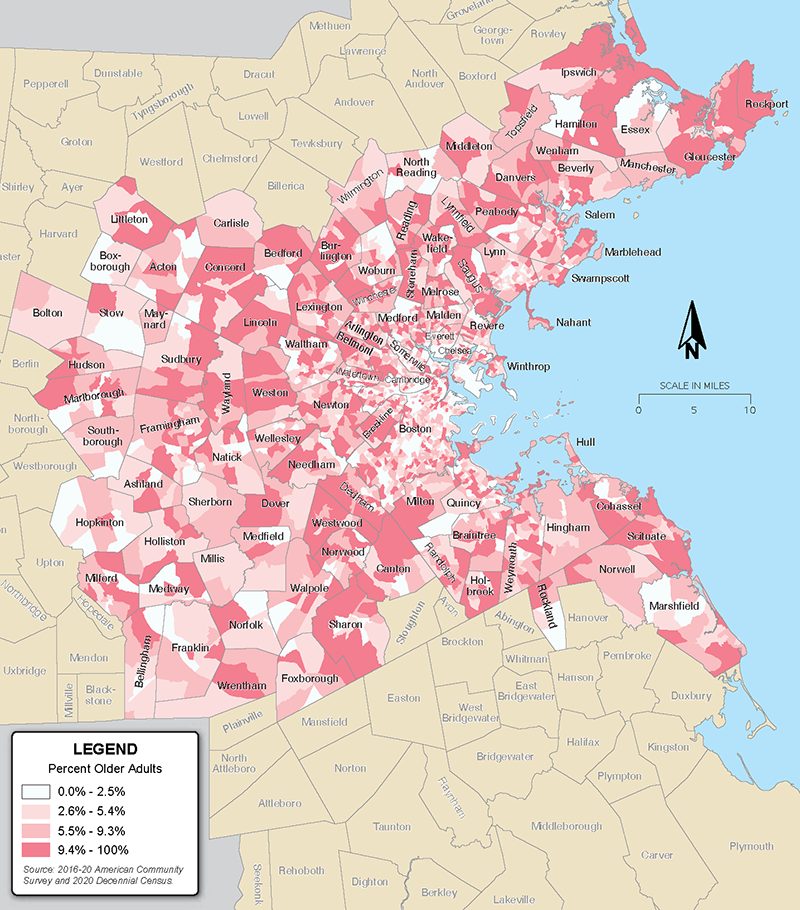
Source: 2016–20 American Community Survey, Table B01001.
There are 634,550 people who are younger than 18 years in the Boston region, or 18.9 percent of the population. Figure 7 shows the percent of the population in the Boston region who are under age 18.
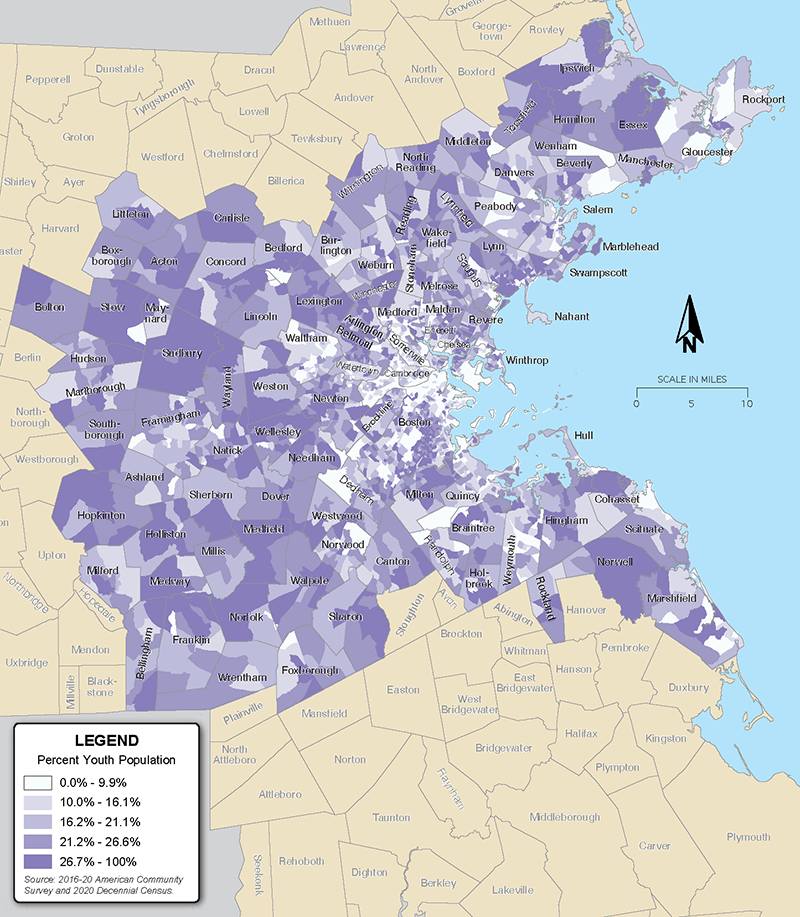
Source: 2016–20 American Community Survey, Table B01001.
The MPO has completed several analyses that examine the distribution of MPO funding. As per federal guidance, minority and low-income populations are analyzed separately in all of them.
MPO staff completed an analysis and map of public transit projects in the FFYs 2023–27 TIP. The analysis shows the distribution of all transit projects relative to the distribution of minority and low-income populations in the Boston region. Figures 8a and 8b show the location of transit projects in the TIP, overlaid upon block groups that show the percentage of low-income and/or minority populations. The projects included are only those with a physical location, such as improvements to stations, vehicle purchases, and commuter rail or subway lines.
There are several data challenges that if resolved would facilitate a more accurate mapping of public transit-related TIP projects. For example, beyond the first year of the TIP, it is often unclear which projects will be undertaken under the various MBTA funding programs. Data are especially scarce for bus improvement projects, such as vehicle acquisition—that is, data on the routes or garages where the new buses will be deployed. Without this information, bus improvements cannot be mapped. Similarly, transit funding programs such as the elevator program, positive train control, and systems upgrades often cannot be mapped because the stations, facilities, or lines that will receive the improvements have not yet been identified.
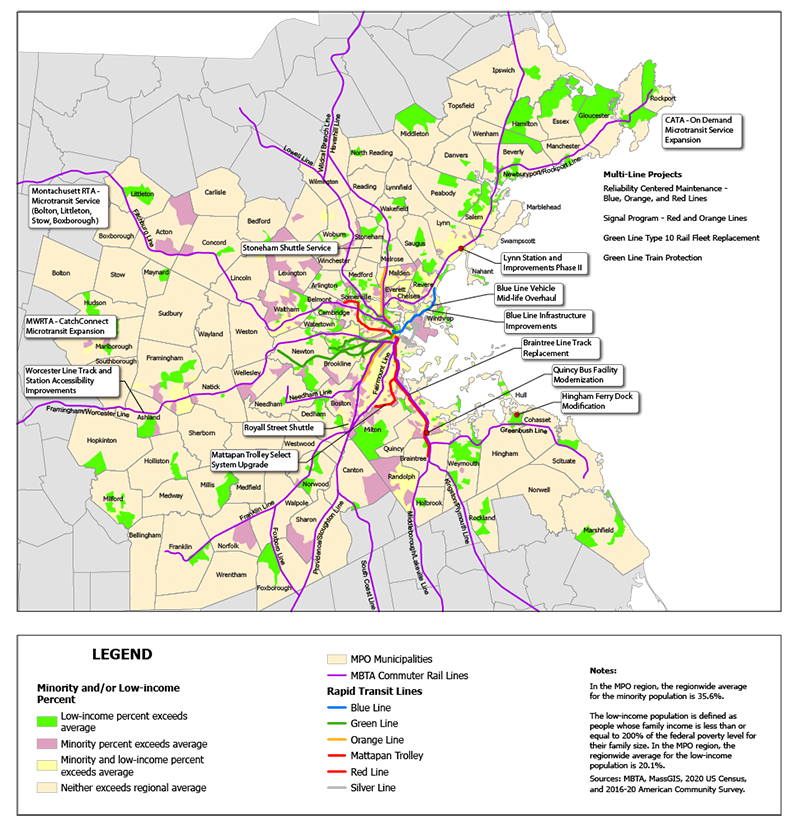
Sources: CTPS; MBTA; MassGIS; and MassDOT.
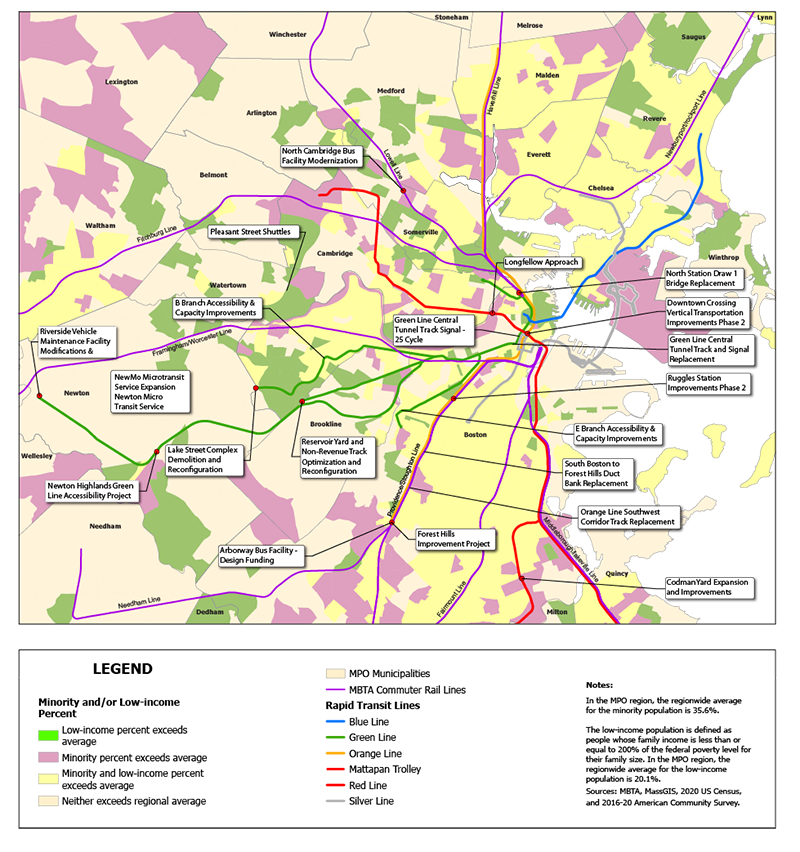
Sources: CTPS; MBTA; MassGIS; and MassDOT.
Each year, MPO staff analyze MPO target-funded projects in the TIP to assess funding distribution among TE populations. Low-income populations and other TE populations are included to understand how transportation investments impact these populations.
Figure 9 shows the percent of TIP target funding allocated to projects benefiting TE populations for the last five TIP cycles, the FFYs 2019–23 through FFYs 2023–27 TIPs. A project is considered to benefit people who live within one-half mile of the project. The percent of funding allocated to projects benefiting the minority population has consistently been about five percentage points less than the percent of their population in the Boston region. The other TE populations have been allocated approximately the same percent of funding compared to the share of the population in the region.
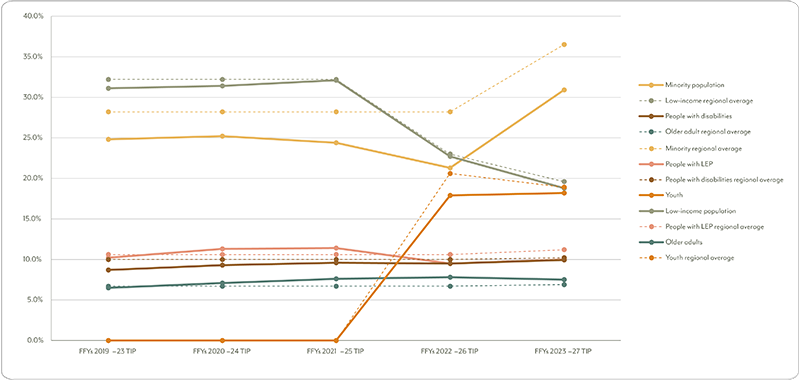
Notes: People ages 17 or younger were not considered as a TE population until the FFYs 2022–26 TIP cycle. Additionally, starting in the FFYs 2022–26 TIP, people with low incomes were defined based on their poverty status for their family size. (Formerly, the definition was based on household income.) The decrease in percent of the low-income population served in the FFYs 2022–26 TIP is largely due to this change, as is the change in the regionwide average.
As is its usual practice, the MPO has left some funds unallocated in the outer years of the TIP, and this analysis does not reflect those funds.
FFY = federal fiscal year. LEP = limited English proficiency. TE = transportation equity. TIP = Transportation Improvement Program.
Sources: US Census Bureau, 2015–17 MBTA Systemwide Passenger Survey, and Boston Region MPO.
Each year, MPO staff determine the investment per passenger for public transit projects, in the aggregate, funded in the Boston region with state and federal funds for low-income and minority passengers. Included in this analysis are MBTA, MetroWest Regional Transit Authority (MWRTA), and Cape Ann Transportation Authority (CATA) projects, as well as MPO target-funded transit projects. Projects were included only if they were expressly for transit purposes, such as infrastructure improvements, maintenance, and vehicle purchases, and if they were funded with state and/or federal dollars. Roadway improvements were not included, even if they would potentially benefit bus passengers. (However, bus-specific improvements, such as bus rapid transit lanes, are included). The analysis was performed with the assumption that all investments result in a net benefit to transit passengers.
Public transit ridership and demographics were derived from the 2015–17 MBTA Systemwide Passenger Survey (SPS), the most recent MBTA passenger survey. Respondents were classified according to four demographic categories: low-income, non-low-income, minority, and non-minority. Because the MBTA and MPO definitions for low-income populations differ, the analysis used the MBTA definition since the data for these populations are available in the SPS. Minority respondents were those who reported being American Indian or Alaskan Native, Asian, Black or African American, Hispanic/Latino of any race, and/ or Native Hawaiian or Pacific Islander.
Tables 7 and 8 show the transit mode shares from the SPS for low-income, non-low-income, minority, and non-minority respondents. Note that the totals are not identical because of the variation in weights that were applied to each population.
Source: 2015–17 MBTA Systemwide Passenger Survey.
| Transit Mode | Low-income | Non-low-income | Pct. Low-income | Pct. Non-low-income |
| Rapid Transit | 160,199 | 444,384 | 26.5% | 73.5% |
| Bus | 117,443 | 166,176 | 41.4% | 58.6% |
| Silver Line | 6,626 | 19,936 | 24.9% | 75.1% |
| Commuter Rail | 6,508 | 89,174 | 6.8% | 93.2% |
| Commuter Boat | 76 | 2,748 | 2.7% | 97.3% |
| MBTA System Total | 290,852 | 722,418 | 28.7% | 71.3% |
Source: 2015–17 MBTA Systemwide Passenger Survey.
Figures 10a and 10b show the per person transit investments for minority, non-minority, low-income, and non-low-income public transit passengers for the FFYs 2019–23 through FFYs 2023–27 TIPs. Over the past five years, transit investments from all sources in the Boston region peaked in the FFYs 2019–23 TIP for all populations and then decreased. For projects funded only with MPO target funds this is in large part a function of the completion of the Green Line Extension, which the MPO funded through several TIP cycles, ending in the FFYs 2020–24 TIP. Public transit investments from target funding are likely to go back up again—indeed, funding is already on an upswing in the FFYs 2023–27 TIP—with the implementation of the MPO’s new Transit Modernization Program. It is less clear how public transit investments from all sources will change since most of that funding comes from the MBTA and Regional Transit Authorities.
Among target funds, the amount of funding allocated to minority and low-income populations on a per-person basis has consistently been less than for the non-minority and non-low-income populations, respectively. In the FFY 2019 TIP, the minority population received 55 percent of the amount the non-minority population received. In the FFY 2023 TIP, the figure was 75 percent. The low-income population received 68 percent of the amount the non-low-income population received in the FFY 2019 TIP; in the FFY 2023 TIP, that figure decreased to 64 percent.
Among all transit projects funded in the Boston region, these ratios are slightly better but still unequal. In the FFY 2019 TIP, the minority population received 68 percent of the amount the non-minority population received. In the 2023 TIP, the figure was 84 percent. In the FFY 2019 TIP, the low-income population received 73 percent of the amount the non-low-income population received; in the FFY 2023 TIP, that figure increased to 83 percent.
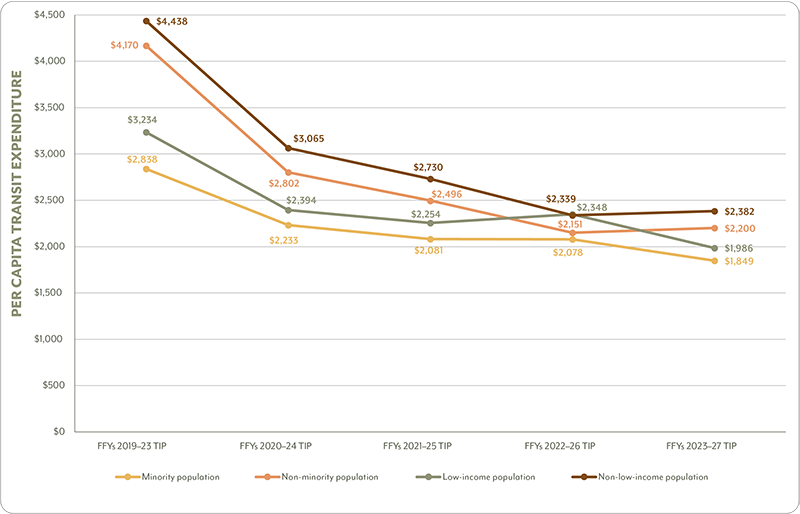
Source: 2015–17 MBTA Systemwide Passenger Survey; MBTA.
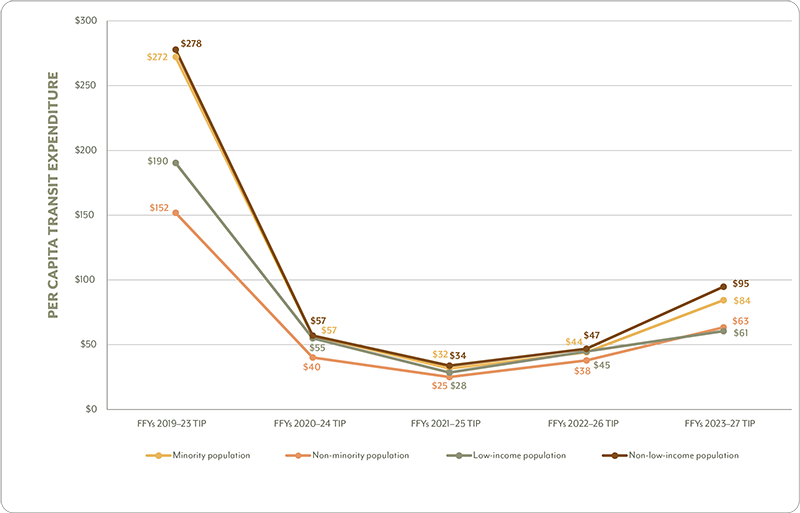
Source: 2015–17 MBTA Systemwide Passenger Survey; MBTA.
Each year, the MPO conducts a geographical assessment of the distribution of MPO-funded UPWP studies and technical support activities. Appendix G shows which communities in the region have been the subjects of MPO-funded studies or recipients of technical support from the MPO, as well as 3C-funded work completed by the Metropolitan Area Planning Council, for the FFYs 2010 through 2022 UPWPs. For each municipality, the table includes the population that is minority, low-income, or has limited English proficiency, as well as the number of UPWP tasks that have occurred in each FFY.
Overall, there does not appear to be a strong relationship between the number of studies and the percent of a municipality’s residents who are minority, low-income, or have limited-English proficiency. Boston, for example, has been the subject of 60 studies since 2010 and has among the highest percentages of these populations. In contrast, Randolph, where 73.4 percent of the population is minority, had only six studies.
Not all municipalities have a study in any given FFY, but the assessment covers several years to provide the MPO with a fuller picture of which municipalities UPWP studies are and are not serving. Assessments excluded client-funded studies, those with a regional focus, and all work related to certification requirements and MPO administration, resource management, and support activities.
One of the ways the MPO works toward achieving equity is to ensure that transportation projects that the MPO funds, in the aggregate, are not discriminatory toward minority and low-income communities. Between 2018 and 2020, MPO staff undertook an extensive public engagement process to develop a Disparate Impact and Disproportionate Burden (DI/DB) Policy that would help achieve that goal. The policy allows the MPO to evaluate the impacts of the projects in the LRTP, as a group, on the minority and low-income populations living in the Boston region. Impacts on minority populations are compared to those on non-minority populations. Similarly, impacts on low-income populations are compared to those on non-low-income populations. The DI/DB Policy determines whether the difference in impacts between each of the two population groups is likely the result of unintentional discrimination.
In developing the policy, the MPO’s goal was to create a policy that reflected the need for minority and low-income populations to be protected from unintentional discrimination and would be useful as a proactive planning tool to prevent such discrimination. MPO staff turned to the processes established by the US Department of Justice to identify disparate impacts for Title VI analyses and by the US Department of Transportation for identifying disproportionate burdens for EJ analyses. Because the criteria for determining disparate impacts and disproportionate burdens are similar in nature, the evaluation for both involve the three steps below:
The MPO developed a DI/DB Policy that consisted of three thresholds, one for each step. A disparate impact or disproportionate burden would be indicated if all three thresholds, shown below, were passed:
The MPO analyzes several metrics for disparate impacts and disproportionate burdens in the LRTP. In the current LRTP, Destination 2040, the following metrics were used:
With the next LRTP, Destination 2050, planned to be completed by the summer of 2023, staff will use updated metrics, including new ones such as access to essential places and access to parks, as well as updated data for existing metrics, such as access to higher education.
In 2019, staff completed a DI/DB analysis for the LRTP, Destination 2040, which included both MPO target-funded projects and all federal-funded projects in the Boston region. As the final DI/DB Policy was not approved until November 2020, staff used an interim one. In sum, it stated that there would be a potential future disparate impact or disproportionate burden if
Both the draft policy and the final policy incorporate uncertainty into the MPO’s DI/DB analyses. As a result, the DI/DB analysis results show the range of values for the build scenario (the scenario in which all programmed projects are implemented) that is expected based on the uncertainty. (For example, if a change in carbon monoxide emissions is predicted to be 10 kilograms and the forecasting error is 10 percent, then the range of expected values would be 9 to 11.) The full results for the DI/DB analysis for Destination 2040 can be found in Appendix E.
Below are additional links to the DI/DB analysis and policy documentation:
The MPO assesses the impacts of all target-funded projects, as a group, on TE populations in each TIP. As standard practice, the MPO leaves some target funds unprogrammed each year to accommodate cost increases and future projects. In addition, the MPO reserves funds for certain investment programs, such as Community Connections and Transit Modernization, with the expectation that they will be allocated when projects are ready to be funded. These unprogrammed funds are not included in the analyses. (See Appendix F for the results of the FFYs 2023–27 TIP Title VI and EJ analyses.)
The TIP Title VI and EJ analyses assess which TE populations are likely to be served or impacted by regional target-funded projects programmed in the TIP. There are several analyses that provide this insight:
The major constraint to implementing more sophisticated analyses is the limited time available to perform these analyses. TIP projects are typically not selected until March of each year and the full TIP document is released for public review by the end of April. Therefore, any analyses must be completed within that timeframe. In addition, there is often limited quantitative data on project impacts that can be analyzed for the purposes of EJ and Title VI analyses.
A potential new tool that could help with the analysis is the destination access tool, Conveyal, which analyzes the ability of people to access destinations in the region within a given travel time. Because it is quick to run, it could potentially be used to analyze access for the Title VI and EJ analyses in the TIP. Staff will continue to explore this and other opportunities for adding new metrics to the TIP Title VI and EJ analyses.
Meaningful and equitable public engagement is foundational to the MPO’s planning and decision-making. The MPO’s approach to engagement is centered on the development of strong relationships with members of the community, particularly groups and organizations representing TE populations who have historically been underrepresented in the planning process.
This approach requires an understanding of the historical and demographic contexts of the communities that are engaged, and a commitment to meeting these communities where they are by developing creative and flexible engagement strategies. This is especially important when engaging harder-to-reach equity communities. Approaches include attending both virtual and in-person community meetings and events during and outside of regular business working hours, building trust with small-scale neighborhood, civic, and advocacy organizations, and partnering with other organizations to distribute surveys and conduct focus groups in languages other than English.
It also requires a commitment to equity in the collection of qualitative data, through awareness of the effectiveness of our engagement in terms of what types of communities staff are reaching and being more intentional about seeking representation from TE populations.
The LRTP Needs Assessment is the process by which staff identify transportation needs in the Boston region. While the development of the Needs Assessment is most intense in the year leading up to the release of the MPO’s LRTP every four years, it includes all input received through public engagement in the years since the last LRTP.
To support the Needs Assessment, staff engage a diverse range of stakeholders in the region. This engagement happens continuously as staff track needs expressed by stakeholders in various settings, including both LRTP-focused engagement and conversations or events happening in other venues or contexts. Conversations with municipalities and transportation professionals are an important component of the Needs Assessment process, but staff also prioritize the inclusion of diverse perspectives from individuals and groups representing a broad range of demographic and community types throughout the region, with a particular emphasis on engaging historically underrepresented and underserved/overburdened communities about their transportation needs. To that end, staff seek to ensure that engagement for the LRTP and across other programs is not just holistic and meaningful, but also quantifiable. (See
Section 3.5.2 on staff’s use of qualitative data.)
Needs voiced by the public during a wide range of engagement activities are cataloged, and all feedback and comments are organized into themes. They are further grouped by equity tags (such as transportation concerns that are related to minority populations or people with limited English proficiency). The collection and analysis of this information is coordinated across engagement, TE, and planning staff to assess the effectiveness of engagement efforts, share information that is relevant to multiple programs or projects, and shape strategies to continuously improve the effective and equitable collection of qualitative data.
Transportation needs are also collected through the development of the Coordinated Plan. One of the main functions of the plan is to identify unmet transportation needs for seniors and people with disabilities in the Boston region through extensive public engagement and identify strategies and actions to meet those needs.
The Coordinated Plan is completed every four years, along the same timeline as the LRTP. This is intentional so as to coordinate public engagement for both processes and to help ensure that the input from seniors and people with disabilities can inform LRTP decisions, such as the development of new investment programs, which define how the MPO spends its target funds through the TIP. Engagement is largely done through focus groups and interviews with people who work closely with seniors and people with disabilities, such as councils on aging and regional coordinating councils. The MPO’s newly established Transit Working Group also hosts coffee chats on specific topics related to transit, including human services transportation, and staff use these meetings to gather input and inform attendees about the Coordinated Plan. Additionally, staff use surveys to gather needs more directly from seniors and people with disabilities themselves.
At the core of the MPO’s public engagement process for the DI/DB Policy was a stakeholder working group convened with the primary purpose of guiding the MPO's decision on setting the values of the three thresholds contained in the Policy (see Section 3.3.1). Creating a DI/DB Policy through a transparent public process, with the involvement of both stakeholders who work with and represent the interests of minority or low-income populations and the MPO board, built trust that the policy will be an effective tool for preventing unintentional discrimination. In addition, stakeholders brought with them an intimate understanding of the lived experiences of people in minority and low-income communities and the inequities they face.
The role of the stakeholders was to help staff
Throughout three meetings in 2018, stakeholders discussed the role of the DI/DB Policy in advancing equity in the Boston region, how the DI/DB Policy could be designed to prevent discrimination, and impacts that the MPO should analyze for potential disparate impacts and disproportionate burdens. At the third meeting staff asked stakeholders to provide recommendations for the policy’s three thresholds. MPO staff spent the subsequent two years addressing this and other recommendations.
In 2020, MPO staff developed a proposal for a final DI/DB Policy. The policy reflects an important recommendation from stakeholders, which is that any impact that adversely affects either the low-income or minority population more than the non-low-income or non-minority population, respectively, would be considered a disparate impact or disproportionate burden. In August 2020, MPO staff brought this proposal back to the stakeholders for their discussion and recommendations. In general, stakeholders were supportive of the proposed policy. On November 5, 2020, the MPO board endorsed the DI/DB Policy.
In 2021, staff completed updates to project selection criteria for the TIP. The TIP criteria include several equity-related criteria; the update doubled the share of these criteria of the total possible score (from 10 to 20 percent). Also, rather than being a stand-alone set of criteria that only assesses the percent of TE populations living in project study areas, each project now receives equity points based how well the project improves transportation outcomes for these populations.
To help determine which transportation outcomes should be part of the new equity criteria, staff conducted extensive surveying and public engagement, with a focus on getting input from disadvantaged populations and communities. While this informed all the criteria, not just the equity criteria, staff used this input to select criteria that emerged as most critical to evaluate in the equity scoring.
Another key touchpoint facilitating public engagement through planning processes are MPO-funded studies and technical assistance. Staff strive to include the collection of qualitative data through meaningful community participation in all studies, particularly those that have an equity focus or involve communities where there is a high share of TE populations. Staff seek input from municipal and agency stakeholders as well as advocates, community-based organizations, and members of the public when conducting studies. Staff employ a variety of both virtual and in-person engagement methods including one-on-one conversations, attendance at community or organizational meetings, focus groups, advisory committees, and surveys to collect qualitative data.
For surveys, staff always include a block of demographic questions to track and evaluate the distribution of responses alongside the responses themselves. In doing so, staff can identify over- and under-represented communities and adjust engagement strategies accordingly to address feedback disparities. When advertising surveys, staff use demographic data from the Census and MassDOT’s Engage tool to understand the demographic nuances of the audiences that are being engaged, especially in terms of the prevalence of languages other than English that are spoken. This enables staff to distribute translated materials efficiently and effectively and ensure that surveys are accessible to all audiences.
The MPO also conducts studies in response to community input. For example, a coalition of advocacy and community organizations proposed an FFY 2022 study, Equity and Access in the Blue Hills. Those proposing the project noted that the Blue Hills Reservation just south of Boston is very difficult to get to from Boston without a car, and that it is often easier for people driving from suburbs to get there than it is for people living just a few miles away in EJ communities such as Dorchester, Roxbury, and Mattapan, where many residents rely on public transit. MPO staff scoped the study based on the coalition’s proposal and began the study by convening an advisory group composed of the proponent coalition and additional community, agency, and municipal stakeholders. This study was led by staff in the MPO’s Communications and Engagement group, who also conducted additional targeted engagement throughout the study to community-based organizations and neighborhood associations in and around Mattapan (including organizations representing EJ and LEP communities).
Staff worked with the advisory group throughout the study, and the group’s input directed all aspects of staff work, from a research review to external engagement activities to technical analysis, final recommendations for public transit interventions to improve access, and the presentation of results. Staff intend for this type of continuous stakeholder engagement to be a model for future UPWP studies that have strong community engagement components, and that this approach will be a meaningful step for the MPO towards stronger community involvement in decision-making processes.
The MPO collects demographic data on TE populations primarily from the Decennial Census (DC) and American Community Survey (ACS). Staff collect new data each year when new datasets are released. They are used in equity-related analyses, including scoring of TIP projects, LRTP Needs Assessment, Title VI reporting, LAP, and the LRTP and TIP Title VI and EJ analyses, among others.
Datasets that complement the ACS and DC data are also used as needed. For example, for the LAP, staff use English-language-learner data from the Massachusetts Department of Education, which has more detailed information about the languages spoken in MPO communities, as a supplement to ACS data.
Data are generally reported at the census block group or tract level. Staff balance the granularity that smaller geographies provide with the larger margins of error that are present. Particularly considering the increased privacy protections employed in the 2020 DC, staff continue to seek to better understand the benefits and drawbacks of using different geographies for different analysis purposes.
Over the past several years, the MPO has shifted toward analyses that focus on understanding project impacts on TE populations, rather than assuming that people who live near a project will benefit from it. This change is reflected in the project selection criteria for the TIP that were updated starting in FFY 2022. This approach is also used with the DI/DB analysis for the LRTP and the air quality analysis that is part of the TIP Title VI and EJ analyses.
With the acquisition of Conveyal in 2021, the MPO can measure access to destinations far more quickly and easily than it could in the past using the travel demand model. In 2022, staff completed a study, Identifying Transportation Inequities in the Boston Region, that used Conveyal to determine if there are inequities in access to various destinations for minority populations, low-income populations, and zero-vehicle households. In FFY 2023, staff will explore opportunities for expanding on the work done on that study to develop a broader set of metrics that identify baseline inequities for several different transportation metrics, such as travel time and air quality. The intention is to use these data to support the MPO’s decision-making process to improve transportation outcomes for equity populations.
Additionally, with the introduction of CTPS’s new Data Program in FFY 2023, staff will be developing a more comprehensive approach to managing data across the agency, including demographic data. From the perspective of the Title VI Program, this will help ensure consistency in how the data are collected and used throughout CTPS, as well as allow the program to capitalize on emerging datasets, demographic and otherwise, and analysis tools.
CTPS contains many programs outside of the MPO’s core documents and engagement processes developed for certification purposes. The data collected and analyzed under the TE Program are also used to support these efforts. Examples include the following:
In addition to the quantitative data cited above, staff also rely on on-the-ground knowledge of community partners about the languages that are spoken in communities. Staff seek out and build upon relationships with those communities by engaging community-based organizations, associations, and advocates to discuss transportation needs, priorities, and concerns, and disseminate surveys and other engagement materials to help us collect that feedback.
As described in Section 3.4.2, staff organize and categorize input that is received through public engagement. Comments are tagged based on whether they relate to transportation needs for any TE populations. Staff also create tables and charts and maps where appropriate, for example with responses to multiple choice or ranking survey questions. Finally, staff track the demographics of survey respondents using a standardized list of questions that align with federal definitions of Title VI, EJ, and other non-discrimination populations..
Staff also continue to explore new strategies and tools to support and improve the collection, organization, and analysis of qualitative data such as the needs of equity populations for the Needs Assessment. Staff are currently identifying methods of providing incentives and compensation for participation in focus groups to create more equitable engagement opportunities for harder-to-reach communities. Staff are also exploring digital platforms for tracking engagement and organizing feedback, which would allow better visualizations of which communities are being reached and how across various projects and to plan future engagement accordingly.
